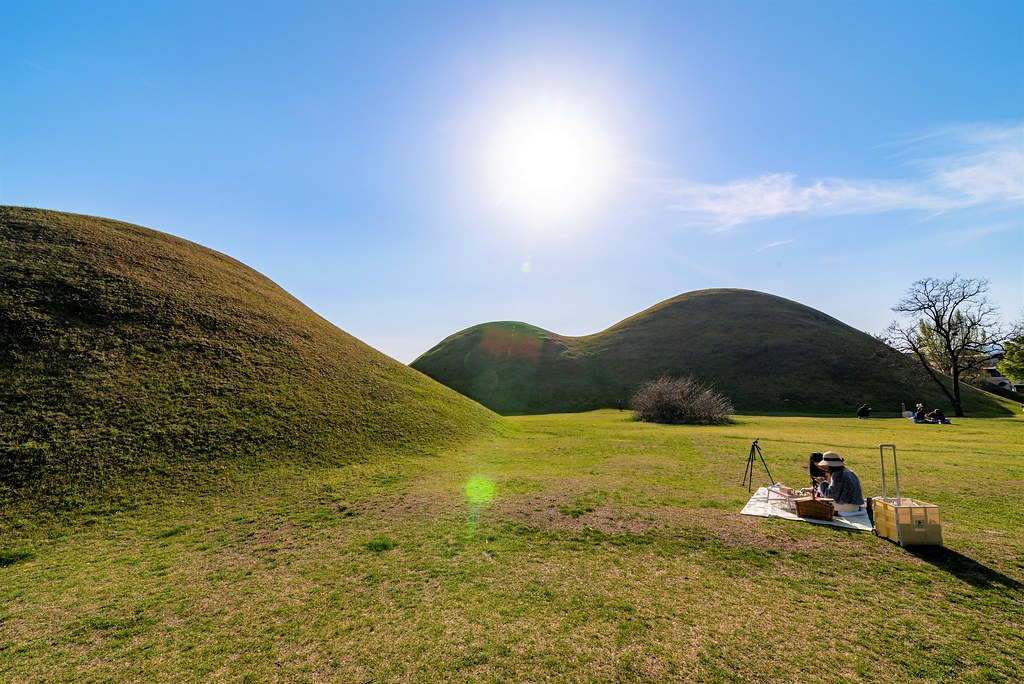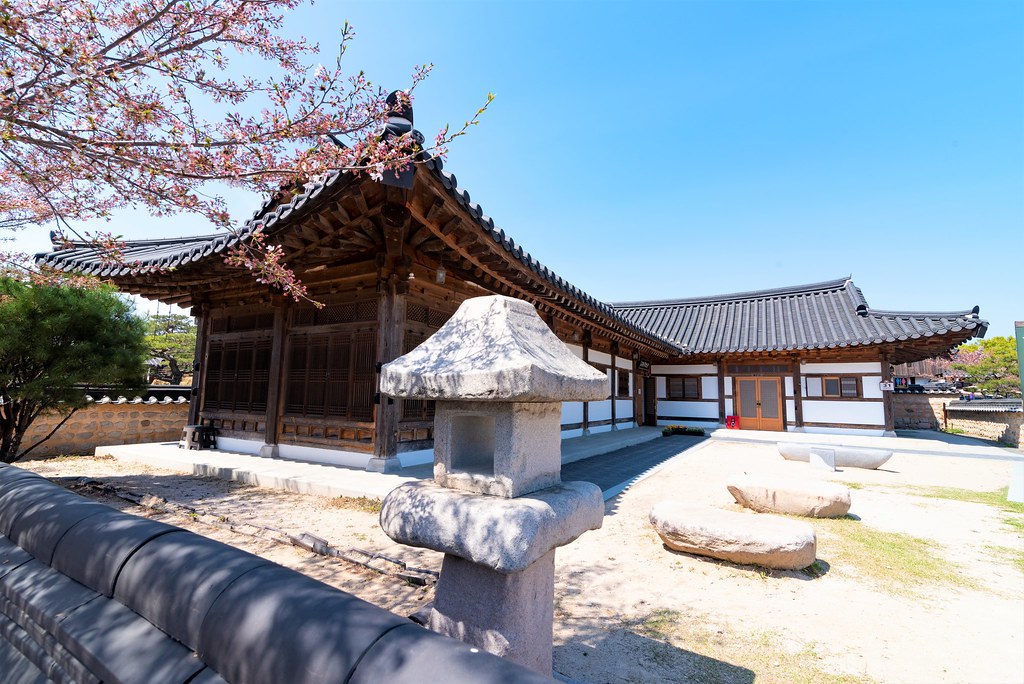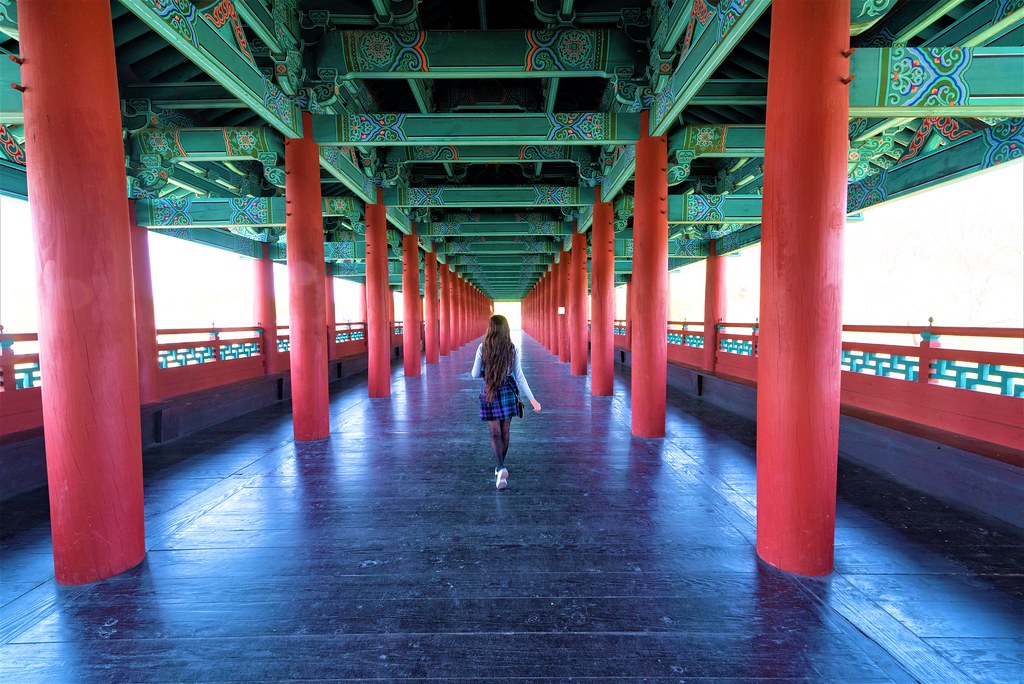With only one day in Gyeongju, you will be packing a lot of things to do, however, even a day will show you the main highlights.
If you have very limited time of a few hours, follow this itinerary strictly. If you, on the other hand, have at least around 8 hours in the city, then you can head to Bulguksa Temple first and then continue with this itinerary.
Day 1 highlights: Royal Tombs, Cheomseongdae Observatory, Gyochon Hannok Village, Woljeonggyo Bridge, Gyeongju National Museum, Donngung Palace and Wolji Pond
See the detailed directions in the day 2 itinerary for Bulguksa Temple.
Here you will find the general post about visiting Gyeongju and possible itineraries.
(In Gyeongju, you can walk among many sightseeing spots. You will have to rely on public transport (use Naver maps for directions, it was very accurate and helpful for us), when visiting the areas outside the center, which you won’t be doing on this day. I will give suggestions if you need to take transport for each location.)
The Daereungwon Tomb Complex
Price: 3000 Won
The tombs are the raised hills you will be seeing around central Gyeongju. Typically, during the Sila kingdom, the tombs consisted of a wooden chamber covered with rocks and mounds of earth. They also applied some clay to ensure that the tombs stayed dry.

The museum holds 23 ancient tombs. It contains tombs of kings and queens, as well as other prominent people of the time – like generals. Several people were buried in some of them. It’s known which notable people were buried in some of the tombs, while no information is available about others. There actually were no entrances to them over centuries, so they were kept intact.
Cheonmachong Tomb here is also well known for displaying the only painting that survived from the Silla dynasty rain, as well as other antiques. Plus, it was rich with various golden artifacts. It is one of the two tombs (along with Geumgwnchong), which you can enter.
Another well-known tomb is that of King Munmu from 3rd century. This tomb is surrounded by a wall and has a gate to enter.
While the tomb complex is paid, there are also a few tombs located north of the complex that are free to wander around. Geumgwanchong tomb can be accessed with a small museum inside providing interesting information about the process of building the tombs, including the wooden chamber inside. This is also where gold crown and various other artifacts were found. While you can visit the tomb itself, the artifacts are housed at the Gyeongju Museum.
 This whole area containing tombs is particularly beautiful during the cherry blossom season, as well as autumn foliage.
This whole area containing tombs is particularly beautiful during the cherry blossom season, as well as autumn foliage.
Note: do not climb the burial mounds under any circumstances. You will be heavily fined and could even be jailed.
Cheomseongdae Observatory
No entrance fees
After exploring all the cafes and restaurants, walk to the Chaomseongdae observatory. Passing it by, you wouldn’t guess this used to be an observatory, however if you learn its history, you will be fascinated. The cylindrical building of Cheomseongdae (in translation stargazing tower) was constructed in the 7th century from 362 pieces of granite – representing 362 days. It’s said to be the first observatory in Korea (or even in Asia), as at the time Gyeongju was at the center of local scientific and cultural development.
You can’t enter the building. Apparently, it used to be accessible by a ladder in the past. A lot of effort goes into the preservation of the site, given that it’s highly susceptible to wear. Its condition is monitored every hour to ensure its protection.

If you are here at the right time in spring, you can find different types of flowers in the gardens around, depending on whether it’s pink muhly season, tulips or cherry blossom season,
Do come back here in the evening as well, as it’s lit at night.
After this, before visiting the Hannok Village, walk around the small streets full of cafes and restaurants. Walk up the Poseok-ro, maybe grab some mandu at the Dosol Maeul, then explore a couple of the many cafes in the area. My favourite was Hulimmog for the fluffy delicious pancakes and Café Ohi for the views.
While walking towards Gyochon village, if you are visiting in spring, you might come by a lovely field, like this one:

Gyochon Hannok Village
No entrance fees
The village showcases the traditional Korean houses – hannoks, which belonged to the rich Choe family. Apparently 12 generations of the family lived here throughout 400 years until 1970. Interestingly, the clan was beloved by the locals – this had many reasons. They were politically neutral – they passed the official exams but never took office. Their tenants paid lower rent for the land they occupied. Whenever the famine happened, they fed the people within 40km radius. Despite all this, the clan maintained its wealth throughout centuries.
Currently, this village offers small museums, hanbok shops, cafes, restaurants, craft stores, workshops and much more. Some of the houses though are private and not accessible.

Gyeongju Hyanggyo – a Confucian government-run school is well-known for enshrining the ancestor tablets, including those of Confucian scholars. The school existed here since 7th century – it was equivalent of current universities. It was closed at the time we visited, as it was being renovated, however, do check if you will be able to visit.
House of the Choe Clan – built in 1700 the building had 99 rooms. It was however damaged in 1970. It is now reconstructed and not one building but several, showcasing the Joseon era living.
Other than these, do wonder around the narrow streets and peek into different buildings, you may find some workshops with clay pots on display, beautiful hanboks, cute yards and much more. You can go to one of the workshops and learn, say, quilting, pottery or glass making. I would say get lost, but you can’t really, it’s too small 😊

Woljeonggyo Bridge
No entrance fees
From the south side of the Gyochon Hanok village you will see the beautiful Woljeong bridge. You might have seen quite a lot of photos of this bridge on social media and for a reason. It’s beautiful built in Korean traditional style. The wooden bridge was first built in the 8th century and reconstructed in 2018, given that it was destroyed.

You can go up the towers on both sides of the bridge for the view and a small exhibition. The bridge is also beautiful lighted at night, if you can come back. We didn’t manage this though.
Fun fact: the bridge was featured in the K Drama The King: Eternal Monarch.-
Gyeongju National Museum
No entrance fees
If you have time before visiting the Donggung palace and are not too tired, you can head to the Gyeongju National Museum. The museum was established in 1945 after the Japanese occupation to house archeological findings of this old city from the Silla period. As mentioned above the museum showcases some of the artifacts found at the tomb complex, around the Anapji (Wolji) pond, as well as other excavation areas around the city.
Donggung Palace and Wolji Pond
Price: 3000 Won
Visit this site last, towards evening, before sunset to make sure that you see the palace during the day, as well as enjoy the light reflections in the pond at night – the palace is open late for that.
The Wolji pond (formerly called Anapji) is an artificial pond around which the palace complex was located. The pond was made here during the Silla dynasty around 7th century by kind Munmu. According to the excavations 5 buildings – parts of the palace were standing around the pond.

The Donggung Palace currently has 3 buildings – pavillions were reconstructed from the materials found during excavations. According to the information provided, the buildings were significantly larger. This secondary palace – that of the crown prince – was first constructed in the 7th century by King Munmu. But the site was completely forgotten after the fall of the Silla dynasty.
While little remains from the original royal glory of this area – almost nothing of the royal palace and only some things from the crown prince’s palace – it’s still a nice place and definitely worth visiting. After checking the pavilions, walk around the pond and enjoy observing the golden fished in the pond, beautiful trees and flowers.


After dark, walk around the pond once again to enjoy the reflections of the pavilions in the pond, which is rather well-known. Hence, most people visit the palace in the evening.
If you still have energy to walk in the evening, I suggest to walk from Donggung Palace back to the Woljeonggyo Bridge to see it lighted, then head to Cheomseongdae Observatory. After all this, you can end up where you were in the afternoon, around the Poseok-ro. you can visit one of the many restaurants and cafes (most of them are very close to each other).
See the dedicated post about cafes in Gyeongju.
See the best suggested 2-day itinerary for visiting Gyeongju if you have longer time.



